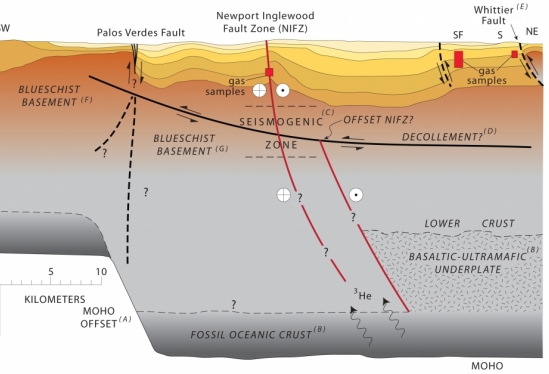| Online: | |
| Visits: | |
| Stories: |

| Story Views | |
| Now: | |
| Last Hour: | |
| Last 24 Hours: | |
| Total: | |
A Deep, Dark Mystery in California, Giant Rift Revealed
The Newport-Inglewood fault was responsible for the 4.9 magnitude Inglewood earthquake in 1920 and the 6.4 magnitude Long Beach earthquake in 1933.
Considered primordial, 3He is a vestige of the Big Bang. Its only terrestrial source is the mantle. Leakage of 3He suggests that the Newport-Inglewood fault is deeper than scientists previously thought. Boles’s findings appear in Geochemistry, Geophysics, Geosystems (G-Cubed), an electronic journal of the American Geophysical Union and the Geochemical Society.
“The results are unexpected for the area, because the LA Basin is different from where most mantle helium anomalies occur,” said Boles, professor emeritus in UCSB’s Department of Earth Science. “The Newport-Inglewood fault appears to sit on a 30-million-year-old subduction zone, so it is surprising that it maintains a significant pathway through the crust.”
Blueschist found at the bottom of nearby deep wells indicates that the Newport-Inglewood fault is an ancient subduction zone — where two tectonic plates collide — even though its location is more than 40 miles west of the current plate boundary of the San Andreas Fault System. Found 20 miles down, blueschist is a metamorphic rock only revealed when regurgitated to the surface via geologic upheaval.
The cylinders Jim Boles used to gather casing gas samples from oil wells along the Newport-Inglewood fault, where he found evidence of helium-3.

Credit: Sonia Fernandez
The study’s findings contradict a scientific hypothesis that supports the existence of a major décollement — a low-angle thrust fault — below the surface of the LA Basin. “We show that the Newport-Inglewood fault is not only deep-seated but also directly or indirectly connected with the mantle,” Boles said.
“If the décollement existed, it would have to cross the Newport-Inglewood fault zone, which isn’t likely,” he added. “Our findings indicate that the Newport-Inglewood fault is a lot more important than previously thought, but time will tell what the true importance of all this is.”
Study co-authors include Grant Garven of Tufts University; Hilario Camacho of Occidental Oil and Gas Corp.; and John Lupton of the National Oceanic and Atmospheric Administration’s Pacific Marine Environmental Laboratory.
This research was supported by the U.S. Department of Energy’s Office of Science and Office of Basic Energy Sciences and by the NOAA Pacific Marine Environmental Laboratory.
Source: http://www.ineffableisland.com/2015/07/a-deep-dark-mystery-in-california.html





